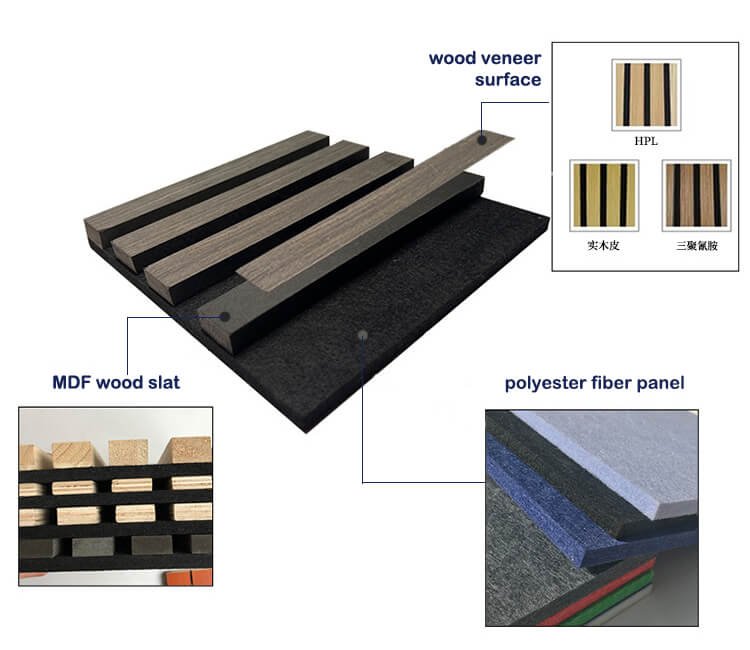How to choose soundproofing or sound-absorbing products?
Wood sound-absorbing panels are a very popular interior design trend in recent years. They can be widely used on walls and ceilings. They not only improve the visual aesthetic effect of the space, but also effectively absorb noise, prevent sound rebound, and improve the sound in the space. quality, making it a popular choice for commercial renovations of homes and office spaces.
Sound-absorbing panels are acoustic solutions for ceilings and wall panels. They mainly absorb sound waves, reduce echo and reverberation in the space, prevent sound rebound, and improve the sound quality in the space. Sound-absorbing panels are usually used in places that have high requirements for sound quality. They can reduce noise and allow you to concentrate better. Such as concert halls, theaters, broadcast rooms, conference rooms, etc.
Can sound absorption reduce noise?
Absolutely. The purpose of using acoustic wood slats to absorb sound in a room is to absorb and suppress sound rebound in the space, improve the quality of sound, and improve the acoustics in the space, thereby reducing noise.

How do sound-absorbing panels work?
The wooden slat sound-absorbing panel is composed of 1mm wood veneer texture on the surface, 12mm MDF wood slats in the middle and 9mm polyester fiber sound-absorbing felt at the bottom. The bottom polyester fiber sound-absorbing felt is filled with soft professional sound-absorbing material, which can capture and preserve sound inside the felt so that it will not bounce back. Just like a ball, if it hits the surface of a hard object, it will rebound. If it hits an object such as a soft sponge, it will stop rolling. Polyester fiber felt uses this principle. When the sound wave hits the wall panel On the surface, its soft characteristics and the sound-absorbing characteristics of polyester fiber will capture the sound, and achieve the purpose of improving the sound quality by absorbing and reducing the echo and reverberation in the space.
Acoustic wall panels are easy to install and only require screws or environmentally friendly glue, making them the best choice for many families to experience DIY projects. He can choose to install it vertically or horizontally according to the overall layout of the space. Vertical acoustic wall panels can even create the illusion of increasing ceiling height, creating the feeling of taller walls.
The texture of the wood veneer on the surface of the acoustic wall panel can be selected in a variety of ways. You can choose your favorite color according to the overall tone and layout of the room, providing more possibilities for the diversity of the room.

What is the difference between soundproofing and sound absorption?
Soundproofing: Its main function is to block sound and prevent part of the sound from propagating. It acts as a sound barrier by preventing sound from traveling and reducing the frequency and amplitude of sound entering your ears. The materials of soundproofing products are generally relatively hard and heavy, forming a thick barrier between two spaces, so that the sound of the external environment is excluded, and the sound generated internally stays inside to prevent the propagation of sound.
Sound absorption: The main function is to absorb noise, absorb sound waves through sound-absorbing materials, reduce sound rebound, and make the sounds in your space sound clearer. The materials of sound-absorbing products are usually relatively soft. The material behind the sound-absorbing part of the indoor sound-absorbing wall panel is made of 9mm polyester fiber sound-absorbing felt. Its soft and porous design is like a sponge, which improves the sound effect of a confined space by capturing sound and absorbing it. Effect.
How to choose soundproofing and sound-absorbing products?
If you want to keep the sound confidential or isolated so that the sound in your own space is not transmitted out and the outside sound is not transmitted in, then what you need is a soundproofing product. Soundproofing products will prevent the sound of your piano room or conference room from disturbing your neighbors, making your space an independent entity without disturbing the people around you.
If you want to improve the sound effect of a closed space and improve the speech intelligibility and sound quality of the space, then you need to use sound-absorbing products. Sound-absorbing wall panels can inhibit sound rebound, reduce noise and reverberation in the space, and improve the sound quality of confined spaces. For example, if you want to hear higher quality sound at a concert without being disturbed by the noise bouncing back and forth, then you need to use sound-absorbing wall panels or sound-absorbing ceilings.

What are some examples of sound absorption?
The principle of sound absorption can be applied to many different scenes and environments:
Recording places that require relatively small sound bounce: walls and ceilings of recording studios and recording rooms
Venues seeking high-quality sound: theaters, concert venues, cinema wall and ceiling partitions
Public areas that need to be kept quiet: base walls of school classrooms, conference rooms, hospitals, offices, restaurants and other commercial spaces, etc.
